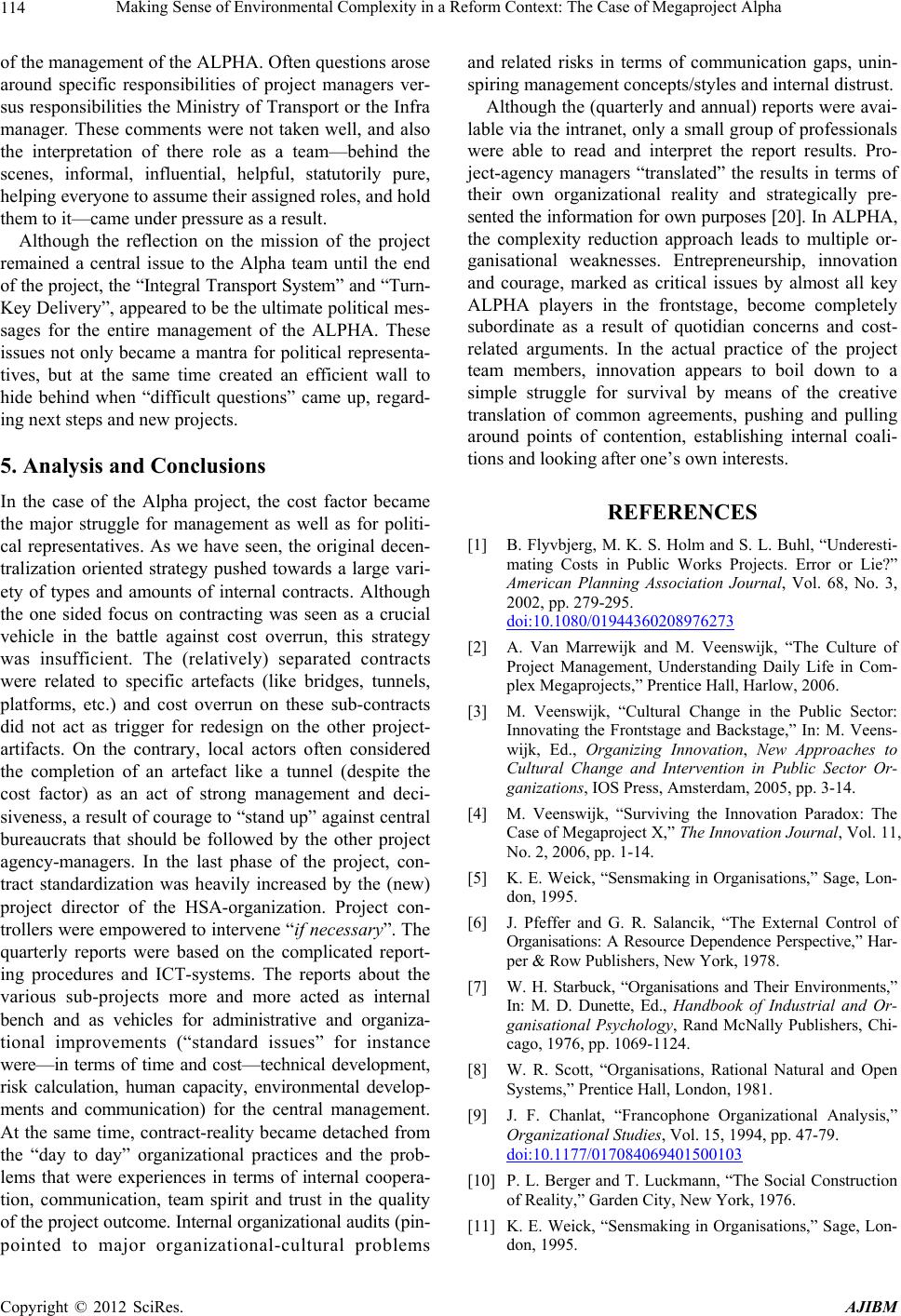
Making Sense of Environmental Complexity in a Reform Context: The Case of Megaproject Alpha
114
of the management of the ALPHA. Often questions arose
around specific responsibilities of project managers ver-
sus responsibilities the Ministry of Transport o r the Infra
manager. These comments were not taken well, and also
the interpretation of there role as a team—behind the
scenes, informal, influential, helpful, statutorily pure,
helping everyone to assume their assigned roles, and hold
them to it—came under pressure as a result.
Although the reflection on the mission of the project
remained a central issue to the Alpha team until the end
of the project, the “Integral Transport System” and “Turn-
Key Delivery”, appeared to be the ultimate political mes-
sages for the entire management of the ALPHA. These
issues not only became a mantra for political representa-
tives, but at the same time created an efficient wall to
hide behind when “difficult questions” came up, regard-
ing next steps and new project s.
5. Analysis and Conclusions
In the case of the Alpha project, the cost factor became
the major struggle for management as well as for politi-
cal representatives. As we have seen, the original decen-
tralization oriented strategy pushed towards a large vari-
ety of types and amounts of internal contracts. Although
the one sided focus on contracting was seen as a crucial
vehicle in the battle against cost overrun, this strategy
was insufficient. The (relatively) separated contracts
were related to specific artefacts (like bridges, tunnels,
platforms, etc.) and cost overrun on these sub-contracts
did not act as trigger for redesign on the other project-
artifacts. On the contrary, local actors often considered
the completion of an artefact like a tunnel (despite the
cost factor) as an act of strong management and deci-
siveness, a result of courage to “stand up” against central
bureaucrats that should be followed by the other project
agency-managers. In the last phase of the project, con-
tract standardization was heavily increased by the (new)
project director of the HSA-organization. Project con-
trollers were empowered to intervene “if necessary”. Th e
quarterly reports were based on the complicated report-
ing procedures and ICT-systems. The reports about the
various sub-projects more and more acted as internal
bench and as vehicles for administrative and organiza-
tional improvements (“standard issues” for instance
were—in terms of time and cost—technical development,
risk calculation, human capacity, environmental develop-
ments and communication) for the central management.
At the same time, contract-reality became detached from
the “day to day” organizational practices and the prob-
lems that were experiences in terms of internal coopera-
tion, communication, team spirit and trust in the quality
of the project outcome. Internal organizational audits (pin-
pointed to major organizational-cultural problems
and related risks in terms of communication gaps, unin-
spiring management concepts/styles and internal distrust.
Although the (q uarterly and annu al) reports were avai-
lable via the intranet, only a small group of professionals
were able to read and interpret the report results. Pro-
ject-agency managers “translated” the results in terms of
their own organizational reality and strategically pre-
sented the information for own purposes [20]. In ALPHA,
the complexity reduction approach leads to multiple or-
ganisational weaknesses. Entrepreneurship, innovation
and courage, marked as critical issues by almost all key
ALPHA players in the frontstage, become completely
subordinate as a result of quotidian concerns and cost-
related arguments. In the actual practice of the project
team members, innovation appears to boil down to a
simple struggle for survival by means of the creative
translation of common agreements, pushing and pulling
around points of contention, establishing internal coali-
tions and looking after one’s own interests.
REFERENCES
[1] B. Flyvbjerg, M. K. S. Holm and S. L. Buhl, “Underesti-
mating Costs in Public Works Projects. Error or Lie?”
American Planning Association Journal, Vol. 68, No. 3,
2002, pp. 279-295.
doi:10.1080/01944360208976273
[2] A. Van Marrewijk and M. Veenswijk, “The Culture of
Project Management, Understanding Daily Life in Com-
plex Megaprojects,” Prentice Hall, Harlow, 2006.
[3] M. Veenswijk, “Cultural Change in the Public Sector:
Innovating the Frontstage and Backstage,” In: M. Veens-
wijk, Ed., Organizing Innovation, New Approaches to
Cultural Change and Intervention in Public Sector Or-
ganizations, IOS Press, Amsterdam, 2005, pp. 3-14.
[4] M. Veenswijk, “Surviving the Innovation Paradox: The
Case of Megaproject X,” The Innovation Journal, Vol. 11,
No. 2, 2006, pp. 1-14.
[5] K. E. Weick, “Sensmaking in Organisations,” Sage, Lon-
don, 1995.
[6] J. Pfeffer and G. R. Salancik, “The External Control of
Organisations: A Resource Dependence Perspective,” Har-
per & Row Publishers, New York, 1978.
[7] W. H. Starbuck, “Organisations and Their Environments,”
In: M. D. Dunette, Ed., Handbook of Industrial and Or-
ganisational Psychology, Rand McNally Publishers, Chi-
cago, 1976, pp. 1069-1124.
[8] W. R. Scott, “Organisations, Rational Natural and Open
Systems,” Prentice Hall, London, 1981.
[9] J. F. Chanlat, “Francophone Organizational Analysis,”
Organizational Studies, Vol. 15, 1994, pp. 47-79.
doi:10.1177/017084069401500103
[10] P. L. Berger and T. Luckmann, “The Social Construction
of Reality,” Garden City, New York, 1976.
[11] K. E. Weick, “Sensmaking in Organisations,” Sage, Lon-
don, 1995.
Copyright © 2012 SciRes. AJIBM